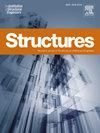Hydrogen/methane explosion loads and their effects on high-performance concrete: A comprehensive review
IF 4.3
2区 工程技术
Q1 ENGINEERING, CIVIL
引用次数: 0
Abstract
As the global energy sector transitions toward sustainability, hydrogen and natural gas (methane) are emerging as pivotal fuels. However, the explosive nature of these fuels poses substantial risks, highlighting the need for precise explosion-loading predictions and robust blast-resistant infrastructure. Although high-performance concrete (HPC) and ultra-high-performance concrete (UHPC) show promise for such infrastructure, their performance under gaseous explosions remains insufficiently understood. This review consolidated current methods for predicting hydrogen/methane explosion loads and for assessing structural response of HPC/UHPC members. Experimental tests (under unconfined, semi-confined, confined, vented, and congested conditions), empirical models (TNT equivalence, multi-energy), and numerical simulations (ranging from one-step to detailed reaction CFD) were examined. Recent advancements in data-driven prediction, such as machine learning and graph neural networks, show potential for improving prediction speed. Particularly, the SALE method, a computationally efficient approach based on user-defined detonation parameters, demonstrated its ability to model a wide range of gas detonations and structural damage scenarios in hydrocodes like LS-DYNA. Key gaps include the lack of dimensionless predictive models and universal data-driven frameworks for diverse blast scenarios. Future research should focus on improving deflagration-load predictions, expanding experimental and numerical databases, and integrating advanced machine learning techniques with numerical simulations to ensure the resilience and safety of HPC/UHPC systems.
氢/甲烷爆炸荷载及其对高性能混凝土的影响综述
随着全球能源行业向可持续性转型,氢和天然气(甲烷)正成为关键燃料。然而,这些燃料的爆炸性带来了巨大的风险,突出了对精确的爆炸负荷预测和强大的防爆基础设施的需求。尽管高性能混凝土(HPC)和超高性能混凝土(UHPC)有望用于此类基础设施,但它们在气体爆炸下的性能仍未得到充分了解。本文综述了目前预测氢气/甲烷爆炸载荷和评估HPC/UHPC构件结构响应的方法。实验测试(无密闭、半密闭、密闭、通风和拥挤条件下)、经验模型(TNT当量、多能)和数值模拟(从一步到详细反应CFD)进行了研究。数据驱动预测的最新进展,如机器学习和图神经网络,显示出提高预测速度的潜力。特别值得一提的是,SALE方法是一种基于用户自定义爆轰参数的高效计算方法,它证明了其在LS-DYNA等氢代码中模拟大范围气体爆轰和结构损伤场景的能力。主要差距包括缺乏针对不同爆炸场景的无量纲预测模型和通用数据驱动框架。未来的研究应侧重于改进爆燃负荷预测,扩展实验和数值数据库,并将先进的机器学习技术与数值模拟相结合,以确保HPC/UHPC系统的弹性和安全性。
本文章由计算机程序翻译,如有差异,请以英文原文为准。
求助全文
约1分钟内获得全文
求助全文
来源期刊

Structures
Engineering-Architecture
CiteScore
5.70
自引率
17.10%
发文量
1187
期刊介绍:
Structures aims to publish internationally-leading research across the full breadth of structural engineering. Papers for Structures are particularly welcome in which high-quality research will benefit from wide readership of academics and practitioners such that not only high citation rates but also tangible industrial-related pathways to impact are achieved.
 求助内容:
求助内容: 应助结果提醒方式:
应助结果提醒方式:


